| – Benefits – How to eat – Contraindications – Cultivation – How to choose – Hybrids |
Pomelo is called a large citron, a swollen lemon, and even a melon apple. Where the first two associations came from is quite understandable, because the exotic fruit belongs to the citrus fruits, but the last name is apparently connected with its shape and size, since neither in taste nor in internal content the fruit is completely similar to either an apple or an apple. melon. It is the largest and “dryest” among its citrus counterparts. Its pulp contains the most elastic fibers - up to 11%. The taste of pomelo is slightly bitter, like grapefruit, but in general terms it is characterized as sweet and sour. The spherical or pear-shaped fruits can grow up to 30 cm in diameter, and their weight can reach 10 kg. Such giants are not found on the shelves of our stores; the maximum is about 1–1.5 kg.
Photo: ©
In open space, a citrus tree can grow up to 10–15 m in height. Its fragrant white-yellow flowers appear singly or in clusters. The pomelo fruit has a thick skin that protects 11–18 segments wrapped in thin skin. They, in turn, hide entire colonies of edible capsules with juice, which are, in fact, fruit pulp. Each slice contains seeds, their number depends on the type of citrus fruit.
It is assumed that the homeland of pomelo is Malaysia. The plant is successfully cultivated in Thailand, as well as in India, southern China, Japan, Israel and Vietnam. The ripening season for the fruit is November-February. Our amateur gardeners have learned how to grow small trees at home and even get fruits.
Photo: © Judgefloro
Benefits of pomelo
The exotic fruit is rich in potassium (more than 230 mg/100 g), which has a beneficial effect on the functioning of the heart and the condition of skeletal muscles. 100 g of citrus fruit contains 17 mg of phosphorus, 4 mg of calcium, 1 mg of sodium and more than 20 mg of ethacrynic acid, which has diuretic properties that help get rid of edema and, to some extent, high blood pressure. The fruits contain 89% water, 0.4–0.8% fiber and protein, no more than 0.3% fat and 10% carbohydrates. 100 g of pulp contains about 50 mg of vitamin C, as in lemon, orange, passion fruit, which is half the daily requirement for an adult and quite enough for schoolchildren 9–13 years old. Everyone knows that ascorbic acid helps strengthen the immune system and is an important component in the prevention of colds. As for vitamins B1 and B2, there are not enough of them in pomelo even for babies.
Photo: ©
Calorie content of pomelo: 100 g of pulp contains about 30–40 kcal, so the fruit has no energy value and fits perfectly into the diet.
One of the beneficial properties of the tropical fruit is its involvement in accelerating metabolic processes and burning fat deposits. It helps eliminate toxins and waste from the body, which has a positive effect on the absorption of nutrients entering the gastrointestinal tract along with other healthy foods. The essential oils contained in pomelo improve mood and increase vitality.
Salad with pomelo pulp Photo: © Takeaway
Storing pomelo
You can store the fruit in the refrigerator unpeeled for 2-3 weeks. If the fruit has already been peeled, it is correct to eat the pomelo for 3 days, then the fruit remains fresh, although with a slightly reduced content of vitamins.
The largest citrus has numerous beneficial properties. It can be consumed either in addition to the main meal or as a separate dish. Prepare some salad with fruit or juice, and its effect will not be long in coming.
Today the food market offers a large selection. Particularly noteworthy is the variety of fruits.
Among them you can find not only those that grow in our gardens, but also many others. For example, a broom. This exotic fruit belongs to the citrus family.
How to eat pomelo fruit
In Thailand, as in China, the fruit is included in the recipes of many national dishes. It is consumed both raw and cooked; the pulp is added to salads, sauces and desserts. Pomelo is combined with fruits and berries, meat, vegetables, dairy products (sour cream, yogurt, kefir, cottage cheese), crab meat and fish, nuts, herbs and even chocolate. It is added to drinks, jellies and ice cream, sprinkled with sugar and salt.
To quickly clean a pomelo, you need to cut off the top and make several longitudinal cuts on the skin with a sharp knife. Next, the peel should be manually detached from the inside of the fruit. The translucent membranes separating the slices should be carefully removed and discarded, as they have a bitter taste. Candied fruits are made from the peel and jam is made, while the spongy white layer is removed and thrown into the trash. The peel is also dried and added to tea or used as an additional ingredient when cooking compotes or sauces.
Photo: © Allenchang
Methods for preparing pomelo
The fruit is used in many dishes, both as an independent product and as a flavoring addition. There are interesting ways to eat pomelo correctly so that it brings as many benefits as possible.
| Cooking features | Principle of use |
| Fresh look | The purified product is divided into slices and eaten |
| Squeezing out the juices | |
| Use, cut into cubes, in salads | |
| Ready meals | Candied fruits, marmalade. They are obtained during the cooking process. |
| Jam, jam | |
| Sauce | |
| Dessert | |
| Compote |
Contraindications
Pomelo is not recommended for use if the stomach has high acidity, so for those who have gastritis, gastric or duodenal ulcers, it would be better to avoid the fruit or eat it in moderate doses. The tropical fruit should be excluded from the diet for people suffering from serious kidney and liver diseases.
Warning: Like any citrus fruit, pomelo can cause an allergic reaction, and drinking juice with medications or alcohol can have side effects that increase or decrease the effect of the latter.
Young children should not be given fruit, and they should begin to get acquainted with it gradually, no earlier than 3–4 years old. The first piece should be no larger than a centimeter cube, and only if there is no allergic reaction, the portion can be slightly increased next time. It is better for pregnant and nursing mothers not to use pomelo, because the allergen can manifest itself on the fetus or defenseless infant.
Photo: © ivabalk (Free Pixabay License)
Contraindications for using pomelo
Pomelo is a fruit that not everyone can eat. Contraindications include:
- children's age up to 1.5 years;
- allergy to citrus;
- any disturbances in the gastrointestinal tract;
- liver and kidney diseases;
- taking any medications.
You should eat pomelo with caution even during pregnancy. During this period, the body becomes more susceptible to all foods, so there is a risk of allergies or bloating, even if there were no such symptoms before. During lactation, you should not consume citrus fruits; this can negatively affect the baby’s well-being.
Growing at home
Pomelo reproduces by seeds and air layering. At home, the first option is used.
Pomelo from a seed
Seeds should be extracted from mature, high-quality fruits, or rather, from their lobules. When choosing seeds, be sure to ensure that they are not damaged or deformed. They need to be washed and dried, and then soaked in lukewarm water for 10–12 hours. Next, it is recommended to germinate the seeds, for which they should be wrapped in a damp cloth (cotton wool, sponge, sphagnum moss) and placed in a warm place for several days, periodically wetting the “cushion”. You can start planting them in the ground after the sprouts appear.
It is necessary to prepare a pot or container (necessarily - with drainage holes at the bottom!). The bottom layer (about 4–5 cm) may consist of expanded clay, crushed stone, crushed brick or pieces of foam. The main soil should contain humus, turf soil and sand. It is recommended to purchase the mixture at a flower shop.
Growing at home Photo: © James Steakley
The sprouted seeds should be placed in holes about 3 cm deep and sprinkled with earth. Stronger sprouts are transplanted using the transshipment method to avoid damage to the delicate roots. When the pomelo has entwined the entire soil layer with its root system, the citrus fruit will need to be moved to a larger container, following the process described above.
Advice Do not replant the plant at the moment of flowering and fruiting!
Regime and care
For good development of citrus fruit, warm conditions (up to +30–35 degrees) and relatively humid air in the range of 65–85% are suitable. During the cold season, the temperature should not fall below +12–15 degrees. When choosing a location, it is necessary to take into account that pomelo loves sunlight, but not direct rays, and does not tolerate proximity to heating devices.
The plant should be watered individually, avoiding drying out or waterlogging the soil. In this case, the water must be settled, melt or rain. Excessive zeal, as well as insufficient care of the pomelo, can cause harm and destroy the plant.
Flowers and buds Photo: © Daderot
Advice In summer, soil moisture should be monitored daily.
Citrus requires:
- fertilizing - mineral and organic fertilizers are sold in stores and markets;
- crown formation - you need to pinch the top when the side shoots are formed;
- protection against pests - it is recommended to use biological preparations rather than pesticides;
- spraying leaves - from a spray bottle 1-2 times a day in summer, once a week in winter and in the shower once a month;
- additional lighting in winter - using a fluorescent lamp or LEDs with a warm color range.
Pomelo flowers can be expected in the third year of citrus life, but fruits are not always set. This can happen in a few years if the optimal development regime of the plant is observed, with proper care and pollination.
Storage
After the pomelo has been peeled, the fruit should not be stored for more than a week, but this citrus remains fresh and tasty for no more than three days.
If you need to keep the broom uncleaned, it is better to keep it in a cool place for a month. For better preservation, there is a proven method: wrap it in food paper, but first generously grease it with vegetable oil.
Is it possible to have pomelo for diabetes?
How to choose a pomelo
The advantage of the tropical fruit is its large size, which allows one fruit to feed the whole family at once. But you need to choose it skillfully, otherwise disappointment will not be long in coming.
You need to know that pomelo, depending on the variety, can have different shades - from soft green to yellow, light orange and even pinkish, so it is hardly worth not bothering to determine the ripeness of the fruit solely by the shade of its peel. We can only say with certainty that the white pulp will be sweeter, and the reddish pulp will be sour, but this again is not a criterion in choosing a citrus fruit, since none of the sellers will peel and cut the tropical fruit.
Photo: © public domain (CC0)
So, what should you pay attention to:
- the color of the fruit should be uniform, without spots;
- the aroma should not contain alcohol notes, the smell of a basement or mold;
- the peel should be moderately dense, without damage, dents or compactions, and the stalk area should be elastic;
- the hand must proportionally feel the weight of the fruit, otherwise it will not be as juicy as we would like;
- Ask to open the fruit wrapped in film; it should not be sticky or too shiny.
How to store
Ripe pomelo should be kept in the refrigerator, but no more than 2–3 months, and if at room temperature (up to +20 degrees), then up to a month in a darkened corner. Citrus fruits must be separated from other fruits and vegetables, but not packaged, as they require oxygen.
Photo: © Mk2010
It is not recommended to leave the fruit peeled, as the pulp dries out quickly. As a last resort, the slices can be wrapped in cling film or placed in a resealable plastic container, and then left in the refrigerator for 1–2 days, no longer. To preserve the aroma of the dried peel, it is recommended to store it in a glass jar under a tight lid.
Advice Pomelo cannot be frozen, since its structure and juiciness change dramatically at subzero temperatures. If you wish, you can put the juice poured into ice molds into the freezer, and send the finished cubes or figures into a deep container for further storage.
How to properly peel and eat pomelo
Citrus can be either large or small. Inside there is a film similar to grapefruit and with the same bitter taste. We’ll look at how to properly clean and eat pomelo below.
Before processing, the fruit must be washed with warm water to remove wax applied for transportation.

There are several ways to remove the peel from fruit. They are used depending on the preparation of the dish to which citrus is added. To free the fruit from the peel, the following can be done:
- Cleaning by hand. If the fruit is small, you can peel it like any orange, removing the skin with your hands and dividing it into slices.
- If the peel is thick and the pulp is in a large white layer, take a knife.

Methods for cleaning with a knife:
- Cut the fruit into 4 parts, remove the peel and film from each with your hands.
- Make a spiral cut, as if peeling an apple or potato, then remove the layer.
- Cut a circle of peel around where the fruit attaches to the branch. Lightly cut the skin together with the film with two perpendicular cuts. Next, picking up the layer with your hands in the center, easily remove the quarters. The remaining film is also removed. Then they are divided into slices and the partitions and shell are removed from each.
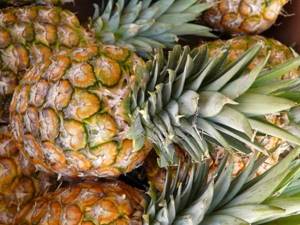
Hybrids
The exotic fruit itself is not a hybrid, a product of selection or genetic engineering, but it can be crossed. The following hybrids with pomelo are known:
- pomelite, oroblanco, sweetie - with white grapefruit;
- tangelo - with tangerine (a type of mandarin);
- mandelos - with tangerine;
- Pomeranian, Kinotto, Bigardia - with a mandarin hybrid;
- hugonatsu - with yuzu.
Hybrid with white grapefruit – sweetie Photo: © Yot
The list of exotic names can be continued, but it would be better to remember the bitter grapefruit, familiar to us from childhood. In 1750, it was first described as a “forbidden fruit” by the British botanist Griffiths Huge. This citrus fruit received its modern name in 1814 thanks to Jamaican traders who compared fruit growing in clusters to grapes. What does grapefruit have to do with it if we are talking about pomelo? As it turns out, there is a direct connection between them.
Not long ago, a group of Chinese scientists published the results of genetic research showing that grapefruit is the result of a natural cross between a pomelo and a sweet orange, in other words, an accidental hybrid of the two. The orange, in turn, may itself be a hybrid of a pomelo and a tangerine.
Choice: tips
Before the pomelo reaches the table, you need to choose the right fruit at the point of sale.
When purchasing you should pay attention to:
- Citrus appearance. If it has dents or damage, it is not recommended to take it. Uneven skin color is also a concern.
- Softness of the peel. If it is hard, it means that the fruit is unripe; the best fruit is considered to be the one that is slightly pressed when pressed.
- The smell that comes from a pomelo. High-quality fruit exudes an elusive, pleasant aroma, in contrast to spoiled fruit with a strong unpleasant odor.
- The mark left when the fruit is lightly pressed. You should not buy one that leaves a noticeable dent when pressed.
Chemical composition and calorie content
Pomelo, like other citrus fruits, is very rich in vitamins. For example, vitamin A is very important for the normal functioning of the visual analyzer; this fruit also contains B vitamins that are no less necessary for our body, and more specifically B1, B2, B3, B6 and in smaller quantities - B12.
An excellent property of pomelo is its high content of ascorbic acid, which is useful for people of absolutely all ages, and especially for children under 10 years of age, as it accelerates growth and promotes normal mental and physical development of the child, increases concentration and perseverance.
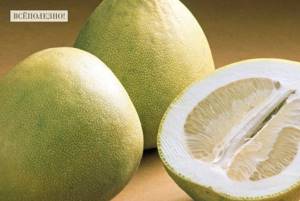
Also, the fruit contains many macro and micro elements, potassium, phosphorus, magnesium, calcium, sodium, zinc, iron, copper are its main components, and all of them are necessary for the body at any time of the year.
It also contains a huge amount of fiber, compared to other fruits. It consists of hard and coarse cellulose, which irritates the intestinal walls and promotes better digestion.
Despite such a rich composition, pomelo has a very low calorie content, only about 30-40 calories per 100 grams of fruit weight. This gives it an advantage over other high-calorie desserts that are harmful to your figure and health.
People who want to easily get rid of extra pounds and quickly tone their body can safely buy this product and actively include it in their diet, for example, use it in fruit salads, low-calorie cakes, or simply as a quick and healthy snack.
How to choose a pomelo
The main difficulty in choosing is the exotic peel. It is thick, so it easily masks most defects. But you can figure it out.
Types of pomelo
At the household level, pomelo is classified according to the shade of its pulp:
- White. The fruits are like a huge amber-yellow pear, the flesh is sweet.
- Pink. A flattened yellow ball, the flesh is sweet and super juicy.
- Red. The fruits are oval, the peel is pure green. The pulp is sour with bitterness.
At the official level, pomelo has several varieties:
- Khao horn – fruit pulp is sweet, whitish; we know it as “Honey”;
- Khao paen - a flattened ball, the exotic flesh is white, with sourness;
- Khao namphung - the fruits resemble a pear, the flesh is sweet, with a yellowish tint;
- Khao phuang - the fruits resemble a pear, the flesh is sweet and sour, yellowish-white.
All exotics have a yellow-greenish peel. The Thongdi variety has a dense green surface. The fruits are spherical, the pulp is sweet, pronounced pinkish.
Fruit color
Before choosing ripe and high-quality pomelo, evaluate the peel of the fruit:
- In different varieties it is moderate green or yellow-green.
- Uniformity and uniform coloring of the fruit is required. Let's say a pink or orange “side”.
- Fruits taken from the branch unripe are unevenly colored. This is also what specimens treated with chemicals look like.
- The color of the peel is too bright due to “chemistry”.
- Dark areas, burgundy spots, grooves, stripes or numerous dots are a sign of mottling, a disease that eats the fruit.
Brownish dents or burgundy areas indicate internal rotting of the exotic. Eating such fruits is dangerous.
The fruit may resemble a pear, a flattened ball, or a rugby ball (oval). It depends on the type and variety.
Many are sure that they should only eat specimens with a tapering tip: they are the sweetest. This is true for pear-shaped or oval fruits. This configuration cannot appear on spherical exotics, but they are sweet.
External conditions are not enough. Important factors are the density and elasticity of the fruit:
- The density of the fruit is checked by lightly pressing on the peel. A ripe pomelo has firm flesh that can be felt even through the peel. But after pressing, the peel returns to its original position.
- Medium density or outright softness of an exotic almost always means that it is overripe or overstayed. That is, it was stored for a long time after harvest before being sold. The taste and texture will be tasteless and “cotton”.
- Unripe fruits are distinguished by increased hardness without a hint of elasticity.
- Often, to preserve marketability, fruits are frozen. However, this kills the citrus. After defrosting, the pulp becomes tasteless. This fruit is easy to identify: when pressed with a finger, the peel and pulp are strongly pressed.
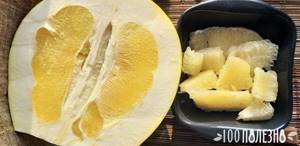
It is easiest to check the elasticity of the top. This is the narrowest segment of the fruit that once held a flower. The ideal is dense and moderately hard. If you feel softness when pressed with your finger or the peel does not return to its place, the fruit is rotting from the inside. It's not worth eating.
When choosing an exotic, it is advisable to “sniff” it. Especially if it is sealed not in film, but in mesh:
- A good fruit has a pleasant citrus aroma with a slight bitterness coming from the peel.
- If the broom smells of mold, moisture or grass, it has most likely begun to rot.
- Unripe exotics have no smell at all.
These nuances differ at short distances.
You should refuse to purchase if the skin of the fruit is intact, but too shiny. Gloss means it has been coated with wax for an attractive presentation. The components of the substance are able to overcome even a thick peel and seep into the pulp.
Such exotics are dangerous for children or allergy sufferers to eat.

Pompelmus - photo in store packaging
Our product is sold packaged in a net. This is a tribute to tradition. In Asian countries this was how crops were protected from animals. There is shrink film inside. It prevents the spread of mold. The downside is that it won’t be possible to determine the degree of ripeness by smell.
A high-quality pomelo has a delicate aroma, as well as some other characteristic features:
- The skin is smooth, without spots, cracks or other damage.
- The place of attachment to the branch is elastic.
- The color is yellow or light green, uniform. Bright green spots on the surface indicate immaturity.
The color of the pulp is usually indicated on the price tag. Pink is the sweetest, but has more seeds. The red one is bitter, and the white one is not so juicy. I liked the fruits with pink flesh. They have the most delicate taste, and the seeds are easy to remove.
Pay attention to the smell. If the fruit does not smell, then it has not yet reached its condition. A ripe pomelo has a weight corresponding to its size. Round fruits weigh 1 kg, pear-shaped fruits weigh 1.5 kg.
Beneficial features
Doctors strongly recommend consuming pomelo about 1-2 times a week, but in small portions. This fruit will be especially useful in winter, during periods of severe frost and exacerbation of influenza viruses and acute respiratory diseases.
Pomelo activates the immune system and helps prevent getting sick! Anyone who uses it at least once a week remains in service in any weather and does not experience headaches or migraines due to sudden changes in pressure.
Speaking of pressure. Experts actively recommend introducing pomelo into the diet of people with cardiovascular diseases, because this product normalizes blood pressure and tones the heart muscle - the myocardium.
Well, the main thing, why all doctors so ardently recommend this dish, is that pomelo slows down the division of cancer cells and reduces the likelihood of tumor formation in old age.
Also, eating pomelo can be an excellent preventive measure in the fight against atherosclerosis. If a person eats too much of the wrong foods, fatty deposits form plaques in the vessels, which impede the flow of blood through them. Those who are accustomed to snacking on fruit do not worry about the appearance of this disease.
Pomelo also has a beneficial effect on the hormonal system. In women, it promotes the production of estrogen, the female hormone, maintains healthy hair and nails, making them stronger and more resistant to external influences.
Pomelo is also beneficial for men. It promotes faster spermatogenesis - the division of germ cells and the formation of sperm, and also improves erection.
Pomelo health benefits and harms
The tasty giant is of great value for the immune and other systems of the body. It boasts the following valuable properties:
- Fights free radicals.
- Heals wounds.
- Stimulates iron absorption.
- Protects against hypertension.
- Reduces weight.
- Helps digestion.
The high content of vitamin C helps strengthen the immune system, improves mood, and improves well-being. Doctors recommend including pomelo in therapeutic diets.
It is eaten when losing weight, to restore strength, and reduce fever. It speeds up metabolism, burns fat deposits, and gives energy.
A study on rats conducted in June 2020 by scientists at Jahangirnagar University (Bangladesh) found that pomelo extract reduced bad cholesterol levels by 41%.
Important! Pomelo is contraindicated for those taking statins. Chinese doctors from Huazhong Agricultural University pay attention to this. The fact is that it contains furanocoumarins. These compounds affect the metabolism of statins.
The product contains valuable enzymes and regulates sugar levels. The zest is rich in flavonoids, coumarins and limonoids. These substances have unique properties.
According to some studies, they block the division of malignant cells, support the functioning of the nervous system, and protect blood vessels and heart muscle.
Regular inclusion in the diet prevents strokes, heart attacks, and atherosclerosis. A high percentage of fiber relieves constipation and supports intestinal function.
Research shows that zest extract activates metabolism and supports the normal functioning of the endocrine system.
A medium-sized peeled fruit contains 230 calories. This is not much at all, considering the size. It contains fiber and amino acids. They keep you feeling full. Regular consumption will help you stay slim and get rid of extra pounds.
Pomelo contains a rare enzyme. It promotes the breakdown of fats and more complete absorption of nutrients. The fruit is used in diets as a “fat burner”.
The high content of antioxidants protects against the negative effects of free radicals and helps preserve youth for many years. It smooths out fine wrinkles, increases skin elasticity, and evens out the relief.
Bioflavonoids and vitamin P help normalize hormones. Essential oils slow down the growth of bacteria and have antifungal properties.
In the early stages of pregnancy, the fruit relieves the manifestations of toxicosis, and in the later stages it protects against edema.
The product improves metabolism, removes toxins and excess fluid. This has a positive effect on complexion. Pomelo reduces the risk of blood clots and helps lower blood sugar levels.
For beauty
Pomelo is an ideal raw material for home cosmetology. The anti-aging effect is manifested even when applied externally. Masks are made from the pulp. They moisturize, nourish the epidermis, and reduce sebum production.
Here's a recipe I especially liked:
- Mash the pomelo slice with a fork.
- Add 5 g of honey and 0.5 tablespoons of mustard oil.
- Apply to face for 15 minutes.
- Rinse off with warm water.
The effect is visible after the first time: peeling disappears, pimples calm down, and the relief is evened out.
If the skin is oily, you can wipe it with pure juice. Dry - only diluted in half with water. With regular procedures, expect significant improvements within a month. The skin will become fresher without peelings and other “executions”.
For men
It is not for nothing that in eastern countries the pomelo is a symbol of health and strength. It will bring great benefits to men at any age. The product strengthens the walls of blood vessels and activates blood circulation. This is an excellent prevention of diseases caused by a sedentary lifestyle.
The fruit will give you a boost of energy after intense training or physical activity. Calcium strengthens teeth and bones, and phosphorus is necessary for the functioning of the muscular system.
In some cases, a broomstick can be harmful. It is not recommended to eat it if you have an ulcer, gastritis or high acidity.
Like all citrus fruits, the giant fruit is a strong allergen. It is better for nursing mothers to abstain from it, while others should exercise moderation.
For chronic diseases, discuss the menu with your doctor, be careful!
How to properly clean a broom
There are different methods of cleaning, you can simply cut the pomelo in half and separate the peel from the pulp, but this is not very convenient and can cause difficulties, because the fruit is quite juicy and you can splash clothes and all the surrounding furniture.
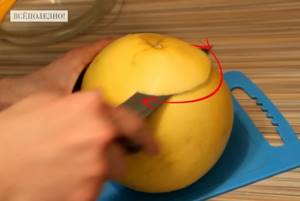
To prevent this from happening, you should take a not very large sharp knife and make 5-6 cuts along the entire diameter along the fruit. You should get triangles that look like slices.
Next, you should cut off the spout, which was mentioned earlier. After the cut, a hole is formed in which the pulp is visible. After this, you need to insert two fingers into the hole formed and tear the fruit in half.
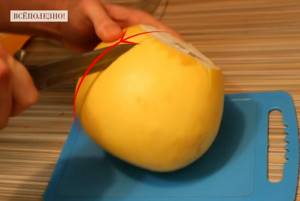
Due to the cuts made at the very beginning, the fruit itself will fall apart into slices and all that remains is to separate the peel from each piece. If you follow all the tips described above and choose the right ripe fruit, then peeling the peel will not be difficult. You will immediately feel the sweet aroma that the pulp emits, but that’s not all.

Next, you should separate the white film from the slices, remove the seeds, if any, put the pulp in a bowl and the fruit is ready to eat. In theory, cleaning seems complicated and confusing, but in practice everything is very simple, you just have to try and strictly follow the instructions, and everything will work out!









